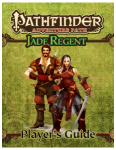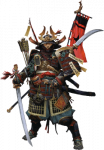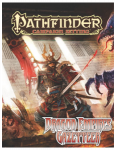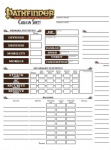Steel_Wind
Legend
 PATHFINDER REVIEW: Overview & Jade Regent Adventure Path Player’s Guide
PATHFINDER REVIEW: Overview & Jade Regent Adventure Path Player’s GuideAuthor’s Note: As part of my continuing coverage of the Paizo/Pathfinder line of products, I will be covering each new release of Pathfinder Adventure Path every month in this column as they are released. Given that the Player’s Guide to the Jade Regent Adventure Path and the first volume of the Jade Regent Adventure Path released at the beginning of August and the second volume of the Jade Regent AP released earlier this month, I already have some serious catching up to do. As such, this article provides an overview of the Jade Regent Adventure Path and the Jade Regent Player’s Guide. Later this week, I will review Pathfinder #48, Jade Regent Vol. 1: The Brinewall Legacy, and Pathfinder #49, Jade Regent Vol. 2: Night of Frozen Shadows.
Overview: The Jade Regent Adventure Path – Four Years + in the Making
Paizo Publishing LLC.’s Creative Director, James Jacobs is a fan of Eastern flavoured RPGs, anime and wuxia fiction. His idea for an Eastern flavoured Adventure Path has been around since even before the days that Paizo transitioned from being a publisher of magazines to a company that publishes books and the Pathfinder Adventure Path. Indeed, the seeds for the Jade Regent Adventure Path were carefully planted within Paizo’s Pathfinder Adventure Path #1 Burnt Offerings with the introduction of Ameiko Kaijitsu, an ally of the party and proprietor of the Rusty Dragon tavern in Sandpoint. The very first edition of Pathfinder Adventure Path explains how Ameiko’s family was exiled from Tian Xia and made their way north across the polar ice at the Crown of the World and down to Varisia, ultimately settling in Sandpoint.
The role that Ameiko’s family had in Tian Xia is not directly disclosed within Burnt Offerings or the rest of the Rise of the Runelords; suffice to say that Ameiko’s role and destiny lies at the heart of the Jade Regent Adventure Path.
Initially, Jade Regent was pitched as the second Adventure Path – a sequel to Rise of the Runelords.
“When Jacobs first pitched Jade Regent to me, it was proposed as our second Adventure Path. We had just started the world setting and I wasn’t sure that people were ready to jump into Asia-land at the time,” Erik Mona, publisher at Paizo Publishing LLC explains. Realistically, Paizo had a number of things it needed to do and there were competing priorities within the various product lines. Despite Jacobs’ best intentions, the delay in returning to Jade was pushed further back into Paizo’s release schedule as the years passed.
Jacobs explains that there was a real intention to publish Jade Regent as the fourth Adventure Path, but by that time the development of the Pathfinder RPG was in full swing and Jade was put off again. In June 2009, Jade Regent was thought viable for release at Gencon 2010 and it was even announced at Paizocon that year. Indeed, James Jacobs ran a party of players through part of an earlier draft of the main dungeon in The Brinewall Legacy at Paizocon II in 2009. However, it soon became clear that the rest of the support books necessary to do Tian Xia simply could not be made ready for August 2010. At Gencon in 2009, Jade Regent was “unannounced” and quickly exchanged for Serpent’s Skull. Later, the schedule for Jade flip-flopped again, and Carrion Crown edged ahead of it in the release cycle.
 Competing priorities were part of the explanation, but it was more complicated than that. The main reason for delaying the release of Jade Regent was tied into the release of Pathfinder RPG and the rest of Golarion. Erik Mona and James Jacobs both realized that in order to set a story in an Eastern themed fantasy setting would require additional both rules and supplement support to enable Paizo to tell the story it wanted to present in Jade Regent. An Eastern flavoured AP would need rules for ninjas and samurai as well as more rules and feats for eastern-flavoured martial arts. Weapons and combat should have rules for katanas, wakizashis, and a whole host of other eastern-styled weapons. Add to this mix a need for Eastern themed monsters and the necessity of expanding Paizo’s world setting, Golarion, to include material for areas analogous to feudal China and Japan -- and the entire endeavour became far more intensive than any six-volume Adventure Path could ever hope to manage on its own.
Competing priorities were part of the explanation, but it was more complicated than that. The main reason for delaying the release of Jade Regent was tied into the release of Pathfinder RPG and the rest of Golarion. Erik Mona and James Jacobs both realized that in order to set a story in an Eastern themed fantasy setting would require additional both rules and supplement support to enable Paizo to tell the story it wanted to present in Jade Regent. An Eastern flavoured AP would need rules for ninjas and samurai as well as more rules and feats for eastern-flavoured martial arts. Weapons and combat should have rules for katanas, wakizashis, and a whole host of other eastern-styled weapons. Add to this mix a need for Eastern themed monsters and the necessity of expanding Paizo’s world setting, Golarion, to include material for areas analogous to feudal China and Japan -- and the entire endeavour became far more intensive than any six-volume Adventure Path could ever hope to manage on its own. Overview: A Convergence in all of Paizo’s Product Lines was Necessary
The entire undertaking required such a large amount of cross-product support from within Paizo that it required the substantial focus and efforts of all of the company’s product lines to converge in order to permit the Jade Regent Adventure Path to be published. Jacobs was candid “We usually have reserved the Adventure Path released at Gencon for traditional swords and sorcery stories and leave the more experimental stuff for February’s Adventure Path release. With Jade Regent and Carrion Crown, they flip-flopped in order. That’s mostly because of the requirements [for Jade Regent] that involves something requiring Tian Xia. We can’t really do something like this without giving people rules for ninjas and samurai and stuff like that and expanding martial arts rules and all these other elements. So it just made sense to release something like that at Gencon when we could get a lot of these books out at the same time and get a lot of people excited about it.”
Accordingly, this past Gencon saw the release of Ultimate Combat, with rules for the Ninja and Samurai classes, increased martial arts options for monks, and rules for Eastern themed weapons. David Gross’ new novel, Master of Devils, which also focuses on a journey to Tian Xia, was released at Gencon 2011 as well. This month saw the release of a new flip-mat, Monastery, an eastern themed Monastic site that would not look out of place as a set in a Shaolin monk film.
 Even still, all of the material for Tian Xia itself has yet to be released and will not be until later this year. In November 2011, a campaign supplement intended for GMs, Dragon Empire Gazetteer will ship, followed in December with the Dragon Empires Primer, a 32-page guide intended for player use. Similarly, in early November, Bestiary 3, which will also feature a number of Eastern themed monsters and NPC races, will be released. For that matter, a campaign supplement detailing the Lands of the Linnorm Kings, useful for GMs running Jade Regent Vol. 2: Night of Frozen Shadows, releases next month.
Even still, all of the material for Tian Xia itself has yet to be released and will not be until later this year. In November 2011, a campaign supplement intended for GMs, Dragon Empire Gazetteer will ship, followed in December with the Dragon Empires Primer, a 32-page guide intended for player use. Similarly, in early November, Bestiary 3, which will also feature a number of Eastern themed monsters and NPC races, will be released. For that matter, a campaign supplement detailing the Lands of the Linnorm Kings, useful for GMs running Jade Regent Vol. 2: Night of Frozen Shadows, releases next month.As it turns out, the release of Tian Xia campaign setting material will be delivered just when it is needed for those running the Jade Regent Adventure Path. Despite the strong Eastern theme and the continent of Tian Xia as the PCs ultimate destination, Jade Regent begins in a swamp outside of a decidedly Western European inspired traditional fantasy town, Sandpoint.
“We wanted to do an adventure set in an analog to feudal Japan, but we also wanted to allow players who were a lot more comfortable playing traditional fighters and wizards to be able to just do that”, Mona explains. Because some players aren’t ready to jump into “Asia-land” with both feet, the Jade Regent Adventure Path is designed so that players and GMs don’t have to if they don’t want to.

Hai Toranaga-Sama, Hai!
The solution to this dilemma of “cultural preference” that Paizo seized upon was to tear a page out of one of the most successful novels and TV mini-series of all time, James Clavell’s Shogun. Originally televised on NBC as a ten-hour miniseries in 1980, Shogun introduced American television viewers to feudal Japan in an adaptation of Clavell’s epic novel to the small screen. The central plot device used in Shogun was to show feudal Japan ca. 1600 through the eyes of a Western visitor to Japan, John Blackthorne, (named Anjin-san by his Japanese hosts). Blackthorne, as a classic fish-out-of-water, permitted readers to be introduced to feudal Japan through the eyes of an English sailor. Clavell’s tale therefore had a foot in Elizabethan England at the same time as it took place almost entirely within Japan during the Shogunate period.
This same fish-out-of-water design of the Jade Regent Adventure Path is very deliberate, channelling the same perspective of Golarion’s Minkai (Paizo’s analog to feudal Japan) as Clavell used in Shogun. In the result, players can continue to play Western themed “Swords and Sorcery” character classes without having to go all-in on Eastern themed classes for their PCs. This aspect of the Jade Regent’s overall plot trajectory is, in my opinion, one of its greatest strengths and presents a perfect solution to the problem of those gamers who just can’t buy into playing an Eastern themed PC, while still permitting those players who do want to play an Eastern themed character to do so.
Moreover, the arrival of the Dragon Empires Gazetteer in November is well timed, as it will not be until Vol. 4 of the Jade Regent Adventure Path is released that the PCs actually reach Golarion’s Far East. For the first three volumes of the Adventure Path, the plot centres upon the discovery of Ameiko’s destiny, the travel of the PCs northwards, through the Land of the Linnorm Kings, across the polar Ice cap at the Crown of the World, and south again until the players reach the lands of Tian Xia.
Jade Regent Player’s Guide: New Rules and Fresh Approaches
All Pathfinder Adventure Paths published by Paizo have been accompanied by a free 16 page Player’s Guide. In very broad terms, each Player’s Guide usually sets out the parameters of the campaign for the player so that he or she can use that information when creating and planning their character. Races are discussed and appropriate race selections are suggested. In terms of classes, a Player’s Guide provides advice to players in terms of what skills and archetypes might be especially appropriate for each class during the course of the campaign. If a class may be inappropriate, the player is warned up front of that fact.
In addition, the Player’s Guides provide new Campaign traits which the player can select for his or her PC that are specially designed for that Adventure Path. While such traits confer an in-game mechanical benefit, the traits are typically described in a manner which fosters a connection with important key NPCs or other organizations present within the Adventure Path so as to provide a story basis for the character’s involvement in the coming campaign.
In the case of the Jade Regent Adventure Path, the information typically presented to players in such guides for their classes is included along with the caution that the player should not expect to be staying in Sandpoint. Additional hints in the free Player’s Guide make it clear that extensive cold-weather overland travel will be required in the campaign via caravan.
In other words, the player is told from the outset that they’ll be traveling to Tian Xia and the Minkai Empire over the Crown of the World – but why is not explained to the player in the Player’s Guide.
In terms of classes, the Player’s Guide suggests that only one class may be inappropriate: the Gunslinger. The Player’s Guide explains that there will not be any treasure in Jade Regent that is appropriate for this class (there are no guns or bullets as treasure in the AP by default); consequently, players should discuss the selection of this class with their GM first.
In terms of campaign traits, players of Paizo’s Adventure Paths will find this Player’s Guide to be somewhat unusual. The Jade Regent Player’s Guide presents four NPCs to the players in great detail, explaining that these four NPCs will be travelling with the party at some point – while leaving the question as to why an open question. The Campaign traits presented in the Player’s Guide are similarly focused on tying the player characters to one of the four NPCs in some manner.
While forging a pre-existing relationship with a particular NPC has long been a typical option in most of the Player’s Guides for the nine Adventure Paths published to date, it is highly unusual for a Player’s Guide to present four NPCs as permanent travelling companions on the players’ campaign long quest.
The last two sections of the Player’s Guide present two entirely new rule systems for use during the campaign. Indeed, the rules for caravans are quite extensive at twelve pages. The caravan rules increase the Player’s Guide to the Jade Regent Adventure Path to 28 pages – unprecedented in a Paizo Adventure Path.

New Rules: Caravans
Apart from the obvious change in where the Jade Regent Adventure Path takes place, “experimental” Adventure Paths that Paizo publish also aim to create new campaign rules and resource management challenges for the PCs. In the immensely successful Kingmaker Adventure Path, Paizo introduced players to a sandbox style campaign of “hexploration,” where they would build and manage their own kingdom and fight a war against a neighbouring kingdom. In Kingmaker, the mini-game was all about “kingdom management”.
Jade Regent is a far more story based Adventure Path than Kingmaker and the focus of the tale is not on sandbox style play. Instead, Jade Regent’s new resource management mini-game focuses upon the caravan that the players will ultimately take northward across the polar cap and down the other side of the globe to reach the Far East.
The caravan rules treat the caravan as essentially a character in its own right. Part ship and part home-base, the caravan levels up along with the player characters. It gets its own record sheet and stat block and the players can choose new caravan feats for the caravan each time the party levels up. A caravan can also be upgraded along the way by spending money and devoting other resources towards it.
Like many aspects of the Kingmaker kingdom management rules, there are aspects of the caravan resource managements rules which don’t make complete arithmetical sense and would have benefitted from the sort of play-testing that the limited development time of an Adventure Path does not permit. For example, it becomes quickly clear that the money a caravan can earn does not make it a very profitable enterprise. Jacobs readily admits this and has suggested that adding a Trader or Merchant feat to the caravan feat list to allow it to double and triple its income would not be out of place for GMs and players for whom this is an issue.

I suppose the fact that the caravan, by default, is not a new source of immense wealth is not necessarily A Bad Thing. Any new campaign mini-game of resource management that potentially adds vast new monetary wealth to the PCs can permit more magic item purchases (or more typically, magic item crafting). Backed by sufficient gold reserves, either approach to magic item acquisition can quickly spiral out of control if a GM is not careful. Accordingly, while it may be that barely tenable caravans do not make great economic sense as presented in the Player’s Guide – their poor investment potential is highly convenient for preserving game balance.
Moreover, the caravans presented in Jade Regent are not of the same sort that Marco Polo would have taken along the Silk Road for profit. Instead, the PCs caravan looks a lot more like a caravan of the Roma or other Travelling People of Europe. This is particularly appropriate, as the Varisian people, the principal settlers in the land where Jade Regent begins, are a cultural analog in Golarion to the Roma. “These are VARISIAN caravans, for the most part, and that means that they're essentially mobile home bases first and everything else second. They're not designed to be profitable trade ventures as much as they are tiny little mobile villages,” Jacobs explains.
For those who are interested in experimenting with the caravan rules without running the Jade Regent Adventure Path itself, you may also choose to seek out modifications and expansions to those rules from third party publishers that have already begun to crop up.
 New Rules: Romance and Relationships
New Rules: Romance and RelationshipsAs mentioned earlier, the Jade Regent Adventure Path introduces a new campaign spanning addition to Paizo’s Adventure Path line: core NPCs. While important NPCs have always been present in every Adventure Path, this is the first one that I can recall which presents a core group of four NPCs in the first instalment that are intended to accompany the PCs throughout their journeys of the course of the entire six-volume campaign. Generally speaking, these four NPCs, Ameiko, Shalelu, Koya and Sandru will spend their time as part of the caravan leading and managing that “home base” as the players depart from the caravan to investigate the adventure sites and pursue plot hooks that present themselves along the way. Ameiko excepted, for the most part, the NPCs are presented without a preset role other than to be companions on the journey, as Paizo is sensitive to the preferences that individual GMs may have concerning such campaign spanning “GM Characters.” While the NPCs are initially higher in level than the PCs are, this disparity should soon right itself by the start of the second instalment of Jade Regent, and the gap will increase in favour of the PCs as the campaign then unspools.
 The interesting element that the core recurring NPCs present is instead shifted from being assistant in combat to being objects of affection or, perhaps, competition. The Player’s Guide presents a new sub-system of “romance” where the PCs can accumulate points during the course of successive adventures to increase their chance to enter into a successful romance with one of the NPCs.
The interesting element that the core recurring NPCs present is instead shifted from being assistant in combat to being objects of affection or, perhaps, competition. The Player’s Guide presents a new sub-system of “romance” where the PCs can accumulate points during the course of successive adventures to increase their chance to enter into a successful romance with one of the NPCs.Clearly, the presence of “romance points” governing some interaction with NPCs was inspired from computer games, especially those produced by BioWare since the days of Baldur’s Gate. For the most part, the entire “Romance Rules” sub-system is presented to the PCs in the Player’s Guide, except for the key numerical romance scores and some other situational bonuses that occur along the way, which are known only to the GM and are reserved for the Adventure Path’s six volumes.
Like all aspects of interaction with NPCs, I think anything that encourages role-playing in a campaign spanning adventure path is A Good Thing. A particular “score” does not mandate sexual success; indeed one might be able to “score” before a devoted pair-bond occurs according to the Romance Rules. Sex is not necessarily love. For that matter, the possibility of same-sex relationships is not mentioned either and is left entirely within the purview of the individual players and GMs to pursue or ignore, as each group may prefer.
I’m happy with a subsystem which leaves the “when and where” of such matters up to the GM and the players as it is inappropriate to treat all groups alike or make other assumptions concerning these matters. Players’ comfort levels with this sort of “mini-game” will obviously vary widely.
Notably, reaction by players to the Romance Rules sub-system has been almost entirely positive so far. As a result, I expect that Paizo will continue to add these sorts of aspects to relationships with important NPCs in future Adventure Paths.
The review of the Jade Regent Adventure Path continues on Wednesday, September 28, 2011 with the review of Pathfinder #48, Jade Regent Vol 1: The Brinewall Legacy.
Attachments
-
 JadeRegentPlayersGuide_500.png162.6 KB · Views: 19,733
JadeRegentPlayersGuide_500.png162.6 KB · Views: 19,733 -
 Hayato350.png117 KB · Views: 14,038
Hayato350.png117 KB · Views: 14,038 -
 Shogun350.png99 KB · Views: 11,338
Shogun350.png99 KB · Views: 11,338 -
 DragonEmpires300.png148.7 KB · Views: 11,463
DragonEmpires300.png148.7 KB · Views: 11,463 -
 Ameiko350.png95.2 KB · Views: 16,053
Ameiko350.png95.2 KB · Views: 16,053 -
 Jade350.png86.1 KB · Views: 23,373
Jade350.png86.1 KB · Views: 23,373 -
 caravan_sheet.png82.2 KB · Views: 20,598
caravan_sheet.png82.2 KB · Views: 20,598 -
 CaravanMapPack300.png113.9 KB · Views: 11,040
CaravanMapPack300.png113.9 KB · Views: 11,040
Last edited:










